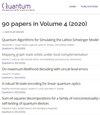压缩量子非马尔可夫性:状态中真正量子非马尔可夫性的度量
IF 5.1
2区 物理与天体物理
Q1 PHYSICS, MULTIDISCIPLINARY
引用次数: 0
摘要
三元量子态$\rho_{ABC}$中的量子非马尔可夫性表示系统$ a $和$C$在系统$B$的条件下的相关性,并且已知具有经典和量子贡献。然而,缺乏对后者的系统描述。为了解决这个问题,我们提出了一个真实量子起源的非马尔可夫性的忠实度量,称为压缩量子非马尔可夫性(sQNM)。它基于量子条件互信息,并由压除所有非量子贡献后的剩余非马尔可夫性定义。它的下界是在约化状态下的非条件系统之间的压扁纠缠,并被任意非条件系统的可扩展性所界定。我们证明了sQNM是单配的,渐近连续的,凸的,张量积状态上的加性的,通常是超加性的。在确定了具有消失的sQNM和不增加状态中sQNM的自由操作的自由状态后,我们通过凸资源理论将真正的量子非马尔可夫性表征为资源。利用资源理论框架对自由操作下的状态变换速率进行了限定,并研究了非自由操作下的状态变换;特别是,我们发现从Bob ($B$)到Alice ($A$)或Charlie ($C$)的量子通信成本的下限是状态中sQNM的变化。sQNM找到操作意义;特别是,在有条件的一次性pad协议的变体中,私有通信的最佳速率是sQNM的两倍。同时,给出了量子解构协议变体的最小解构代价是状态sQNM的两倍。本文章由计算机程序翻译,如有差异,请以英文原文为准。
Squashed quantum non-Markovianity: a measure of genuine quantum non-Markovianity in states
Quantum non-Markovianity in tripartite quantum states $\rho_{ABC}$ represents a correlation between systems $A$ and $C$ when conditioned on the system $B$ and is known to have both classical and quantum contributions. However, a systematic characterization of the latter is missing. To address this, we propose a faithful measure for non-Markovianity of genuine quantum origin called squashed quantum non-Markovianity (sQNM). It is based on the quantum conditional mutual information and is defined by the left-over non-Markovianity after squashing out all non-quantum contributions. It is lower bounded by the squashed entanglement between non-conditioning systems in the reduced state and is delimited by the extendibility of either of the non-conditioning systems. We show that the sQNM is monogamous, asymptotically continuous, convex, additive on tensor-product states, and generally super-additive. We characterize genuine quantum non-Markovianity as a resource via a convex resource theory after identifying free states with vanishing sQNM and free operations that do not increase sQNM in states. We use our resource-theoretic framework to bound the rate of state transformations under free operations and to study state transformation under non-free operations; in particular, we find the quantum communication cost from Bob ($B$) to Alice ($A$) or Charlie ($C$) is lower bounded by the change in sQNM in the states. The sQNM finds operational meaning; in particular, the optimal rate of private communication in a variant of conditional one-time pad protocol is twice the sQNM. Also, the minimum deconstruction cost for a variant of quantum deconstruction protocol is given twice the sQNM of the state.
求助全文
通过发布文献求助,成功后即可免费获取论文全文。
去求助
来源期刊

Quantum
Physics and Astronomy-Physics and Astronomy (miscellaneous)
CiteScore
9.20
自引率
10.90%
发文量
241
审稿时长
16 weeks
期刊介绍:
Quantum is an open-access peer-reviewed journal for quantum science and related fields. Quantum is non-profit and community-run: an effort by researchers and for researchers to make science more open and publishing more transparent and efficient.
 求助内容:
求助内容: 应助结果提醒方式:
应助结果提醒方式:


